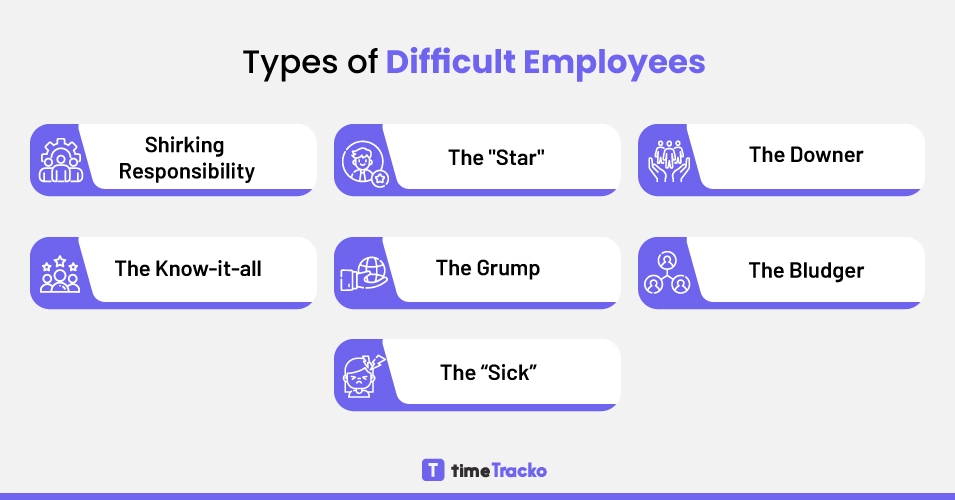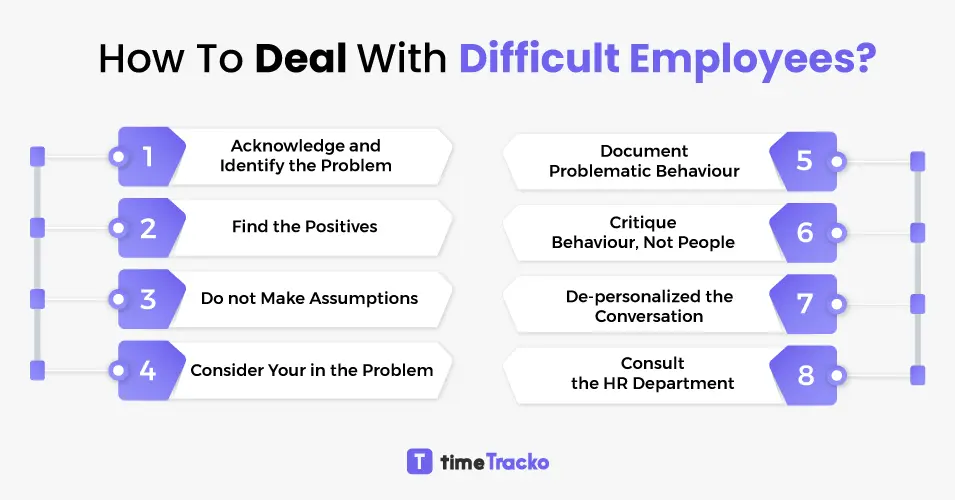<strong>8 Brilliant Ways to Handle Difficult Employees</strong>
8 Brilliant Ways to Handle Difficult Employees
Have you ever worked with someone who drove you insane? The management of employees is one of the most demanding and intensive aspects of running a business. Everyone has a unique personality. It’s inevitable that at some point in your career, you’ll have to deal with difficult employees at work.
Employees who are difficult to deal with are a challenge to manage. This drains you, your company, and other workers. Having people like this makes your job harder, and that needs to be addressed immediately.

Therefore, effective leadership requires knowing how to handle difficult employees quickly and effectively. A manager has to demonstrate leadership, discuss behavioural issues, and develop a clear plan to handle them.
For the sake of your company’s performance and the morale of your employees, managers must monitor the progress of difficult employees and fire those who fail to improve.
We discuss 8 brilliant ways of handling difficult employees in this article.
What is a Difficult Employee?
Difficult employees often act unprofessionally or irresponsibly at work, challenging their supervisors’ authority, creating an atmosphere of negativity at the workplace, or failing to perform to their potential.
As per the Gallup report, 51% of employees are “not engaged” in the workplace and 13% are actively disengaged. People with actively disengaged personalities tend to feel miserable at work and spread negativity among their colleagues.
Everyone hates working with them, yet everyone has to deal with them at work. A difficult employee could sap morale and create a large drain on the productivity of the team if they are left unnoticed by managers.
Types of Difficult Employees
Almost every workplace has at least one difficult employee, and most tend not to show their ugly heads until after hiring. At this point, you are left to deal with them. We have identified basic seven types of difficult employees out of many different types of employees.

1: Shirking Responsibility
Employees who blame others for incidents or make excuses rather than take responsibility when something goes wrong within the company. Sometimes it can be problematic because it isn’t always fair to blame others for your actions.
Letting them know how their actions affected others and making them take responsibility for their actions is the key to making sure it won’t happen again.
2: The “Star”
Employees who are referred to as “stars” are those who regularly arrive late to meetings, never apologize, and spend the entire meeting looking at their phones. There is no doubt that they are good at what they do and want everyone to know it as well.
Despite being highly productive, they are not punctual or apologize for being late. Thus, ignoring the issue just because they are a “star” employee can set an unacceptable example and may lead to more serious problems in the organization’s near future.
3: The Downer
The employee constantly complains about new initiatives and expresses pessimism about them. While it’s important to respect personality differences, their attitude undermines the goals of the company.
4: The Know-it-all
The person may be quick to dismiss other people’s ideas, interrupt others during meetings, and “explain” things beyond their area of expertise, sometimes to experts. Having this type of employee can discourage colleagues from bringing forward new ideas and negatively affect collaboration.
5: The Grump
People with a bad attitude aren’t worth spending time with. However, it is often unavoidable in the workplace. People will attempt to put their best foot forward in an interview and in their first couple of months at work. That glowing, bubbly new recruit can turn into a monster after a while, as their true colours begin to reveal.
You, as a manager, should handle such a situation with maturity. Ask them if are they experiencing some problems in their personal lives or has anything that happened at work triggered them?
6: The Bludger
This type of employee is common. They are at work, but they aren’t actually working. They show up for meetings and send the occasional email, but their productivity doesn’t reflect the hours they spend there.
In order to handle a Bludger, some performance management is required. Schedule regular performance reviews to monitor whether employees are meeting expectations.
By doing so, you can create a timeline for how you plan to assess your employee’s performance. Bludging continues beyond the review period, you should consider terminating the employee.
7: The “Sick”
A sick employee is one who is always absent. Their sick days have surpassed their allotted limits, but this does not seem to bother them. There is always a different medical issue keeping them from work. However, the work just isn’t getting done despite your attempts to be understanding.
Prior to hiring another person for the position, an employee must be absent from work for three months due to illness. In that three-month period, it is always best to obtain a medical certificate for all patients. Request medical proof whenever you are uncertain of an employee’s health or ability to function.
What Does a Difficult Employee Looks Like?
Having a difficult employee at work can cause a toxic work environment, raise staff turnover, and negatively impact customer relations. Below are three examples of how a difficult employee can be.
Scenario 1: The Employee Doesn’t Fulfill Their Responsibilities
There can be a number of reasons why someone is not performing well at work, including lack of ability, lack of motivation, or even lack of resources. Whenever an employee fails to deliver or is unmotivated, don’t write them off as lazy. There may be an underlying cause.
Their frustration may stem from a lack of investment from others, policies and processes that do not improve results, as well as a lack of skills or knowledge needed to fulfil their duties.
Learn more: Major Productivity Challenges and A Guide to Conquer Them📈📈
Scenario 2: The Employee Has a Bad Attitude
The behaviour of a difficult employee can affect the entire team. Having a negative attitude in the workplace creates a toxic working environment. When it comes to bad attitudes at work, passive behaviour is usually more prevalent than direct confrontation.
The not-so-subtle smirk or eye-roll, the tardiness, and inattention at meetings may all contribute to this. Perhaps it’s a more subtly cynical employee who sees everything negatively, even the most positive interactions.
Scenario 3: The Employee Undermines Your Authority
Employees who undermine your authority undermine employee morale and productivity, and they may also question your leadership abilities.
Despite this, not every employee who undermines authority has a bad intention. There are times when employees undermine their managers since they have a different perspective than the manager. Due to their passion for their viewpoint, they may not realize how their communication style undermines others.
How To Deal With Difficult Employees?
Effective management strategies contribute to the success of an organization by encouraging and supporting employees in their efforts to overcome challenges and contribute to its success. For effective employee management, follow these steps:

1. Acknowledge and Identify the Problem
Dealing with difficult employees begins with acknowledging that there is a problem, and then identifying what that problem is. Be as specific as possible in identifying the problems the employee is causing. Whenever there is a concern about the employee’s work performance or behaviour, you should document specific examples.
2. Find the Positives
While it is important to identify the problems with a difficult employee, it is also important to recognize his or her positive characteristics and actions.
Identifying several positive traits or accomplishments to discuss along with your concerns may help you avoid a confrontational and unproductive meeting.
Critical feedback is more likely to be received positively when employees feel their value is also acknowledged.
3. Do not Make Assumptions
Don’t make assumptions. Ask questions to determine whether the person is aware of the impact of their behaviour on the team and why you felt this meeting was necessary. If not, provide specific examples explaining why the meeting is necessary.
Give a concise and factual description of their behaviour and how it impacts the team. Determine if the employee’s personal life is on shaky ground and that this might affect their performance at work. Determine if any external personal factors are at play.
Ensure your employees have access to the company’s resources, like employee assistance programs. However, do not assume that your employees are suffering from outside problems that affect their performance.
4. Consider Your in the Problem
Ask yourself these questions when you are dealing with an employee who is undermining your authority. They will help you understand what your employee is trying to accomplish:
- Do I have a clear understanding of my teammate’s workload?
- Could the employee have a different perspective from mine?
- Does the employee have a valid point?
Ask yourself these questions if you suspect you are being undermined by your employee:
- Are they undermining me by performing their work differently than expected?
- Is the employee putting me down in front of clients, vendors, or coworkers?
- Is the employee undermining me in a negative manner?
Considering these circumstances, it is important to listen to the employee’s feedback because it may contain important insights for the organization. Be a leadership role model by staying calm in the face of problematic behaviour from your employees.
Model the values and company culture you would like to see in them as well. Develop the ability to distinguish constructive criticism from destructive behaviour.
5. Document Problematic Behaviour
When you notice poor performance or troubling behaviour, keep a written record of everything you observe and the date. By documenting specific events, you not only ensure that you remember them and can refer to them in the future but also protect your company from being sued if the employee leaves and sues.
Work with the employee to develop a plan for resolving concerns. Explain your expectations, the method of measuring progress, and the consequences of failing to meet them.
6. Critique Behaviour, Not People
Instead of attacking the employee personally, focus only on the inappropriate or undesirable behaviour the employee has demonstrated. Do not make the conversation too personal or emotional. Don’t provoke a confrontation, instead, strive for a resolution.
The negative behaviour may simply be the result of confusion, fear, or personal problems that you are not aware of. Assist them in achieving their goals by providing them with the tools and resources they need. If necessary, provide them with support.
Create a written record of each step in the action plan and provide a copy to the employee. Establish appropriate timelines for each step.
7. De-personalized the Conversation
Make sure you aren’t making negative statements or accusations. You wouldn’t want to criticize someone for their wrongdoings and demand that they stop in the middle of a difficult conversation.
Ensure your discussion is relaxed and free-flowing, showing that you care and are also there to meet the organization’s goals. Creating a comfortable and professional environment in which the employee feels welcome to talk about their struggles is key to your success.
Keep in mind that this is a business conversation.
8. Consult the HR Department
Organize a meeting with the human resources department to discuss the situation. When it comes to dealing with difficult employees and terminating their employment, HR will understand all the company policies and processes.
The HR department can offer advice on how to deal with the employee’s poor behaviour, help you figure out what documentation you need, and provide you with a plan for addressing the issue with the employee.
Conclusion
Leadership is about communicating effectively with difficult employees. Whether you’re an aspiring leader or a leader in the making, you will need to learn how to communicate effectively with difficult employees.
Prior to taking action, take a calm and rational approach, analyzing all the factors influencing the situation.
FAQs
1. How do you discipline an employee with a negative attitude?
Consider pointing out specific policies in the employee handbook that are being violated. Be clear about your expectations and document your conversation with the employee, along with their response and your plans to address the issue.
2. How do you motivate negative employees?
If you have negative employees at your workplace, talk to them. Ask for their feedback, reinforce their positive behaviour, and let them know you’re there for them whenever they need you.
3. How do you handle difficult employee answers?
Take time to listen to what they say. Do not react spontaneously. Explain what has gone wrong, and then show them how to say the same thing in a polite way.

 in Melbourne
in Melbourne 
 Employee Screen Monitoring Software
Employee Screen Monitoring Software App and Website Monitoring Software
App and Website Monitoring Software Time and Attendance Software
Time and Attendance Software Finance
Finance Banking
Banking Healthcare
Healthcare Lawyers
Lawyers Retail & ecommerce
Retail & ecommerce Knowledge base
Knowledge base Blogs
Blogs Installation Guide
Installation Guide FAQs
FAQs About
About Media Kit
Media Kit Contact us
Contact us